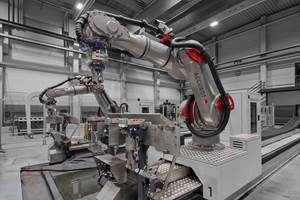Addcomposites releases free professional composites design software suite
Browser-based tools eliminate $320,000 annual licensing barriers, making advanced composite engineering accessible to 50,000-plus engineers and educational institutions worldwide.
Resin Flow Simulator tool. Source (All Images) | Addcomposites Oy
Addcomposites Oy (Helsinki, Finland), a composites manufacturing automation company, has launched a comprehensive suite of free, browser-based composite design software that removes traditional cost barriers preventing smaller organizations from accessing professional-grade engineering tools. The launch addresses a critical gap, where traditional software licensing costs averaging $320,000 annually have excluded 95% of potential users from advanced design capabilities.
The software suite — comprising AddStack for laminate design, Resin Flow Simulator for infusion optimization and Composite Rotor Design Suite (CRDS) for high-speed motor applications — targets growth segments including electric vehicle composites (17.7% CAGR) and aerospace applications (12.8% CAGR). All three applications run directly in web browsers without installation, requiring only simple registration.
AddStack optimizes laminate design through an intuitive visual interface featuring state-of-the-art material databases, real-time mechanical property calculations and multiple failure analysis criteria including Tsai-Wu and maximum stress theories. The platform eliminates complexity traditionally associated with composite laminate optimization while maintaining professional-grade accuracy.
Resin Flow Simulator addresses one of composite manufacturing’s costliest challenges — failed infusions. With VARTM processes achieving only 40-50% fiber volume fraction compared to an optimal 62%, the simulator provides predictive visualization of resin flow patterns, identifies potential dry spots before production and optimizes inlet/vent positioning to prevent the material waste plaguing 5.7% of industry production.
Composite Rotor Design Suite (CRDS).
CRDS targets the emerging $3.2 billion high-speed motor components market, enabling design of composite sleeves for motors up to 200,000 rpm. The platform integrates mechanical stress analysis, electromagnetic field calculations, thermal management and rotordynamic behavior prediction.
“We’re witnessing a fundamental shift in how engineering software is delivered and consumed,” notes James Kuligoski, head of business development and co-founder of Addcomposites. “Our early adopter program ensures we’re building solutions shaped by actual user needs rather than assumptions.”
Addcomposites’ Founding User Program offers exclusive benefits for organizations registering before Nov. 30, 2025:
- Priority access to new features and modules before general release
- Free certification programs valued at €2,000 per user for mastering composite design workflows
- Direct influence on product roadmap through quarterly advisory sessions with the development team
- Dedicated support channel with 24-hour response guarantee
- “Founding User” recognition in the platform and marketing materials.
The initiative targets the potential user base of 20,000-30,000 academic users across 40-plus university programs globally, plus 50,000-plus professionals seeking accessible training tools as the industry faces 622,000 unfilled manufacturing positions.
AddStack.
According to the Addcomposites, companies implementing digital design tools demonstrate 50-64% cost reductions, 15-20% production rate increases and 50% waste reduction. “Educational institutions particularly struggle with software access,” says Pravin Luthada, CEO and and co-founder of Addcomposites. “Universities operate with $25 million in equipment but receive NSF grants of only $500,000-3 million. Free, professional-grade tools enable them to train the next generation of engineers without compromising on capabilities or forcing students to learn on outdated systems.”
The platform supports emerging applications critical to sustainability goals, including wind turbine blade optimization, lightweight automotive structures achieving 40% weight reduction, and battery enclosures for EVs.
Related Content
ASCEND program completion: Transforming the U.K.'s high-rate composites manufacturing capability
GKN Aerospace, McLaren Automotive and U.K. partners chart the final chapter of the 4-year, £39.6 million ASCEND program, which accomplished significant progress in high-rate production, Industry 4.0 and sustainable composites manufacturing.
Read MoreActive core molding: A new way to make composite parts
Koridion expandable material is combined with induction-heated molds to make high-quality, complex-shaped parts in minutes with 40% less material and 90% less energy, unlocking new possibilities in design and production.
Read MoreCorebon induction heating
This sidebar to CW’s August 2024 feature article reviews this technology for more efficient composites manufacturing and why it aligns with Koridion active core molding.
Read MoreAutomated robotic NDT enhances capabilities for composites
Kineco Kaman Composites India uses a bespoke Fill Accubot ultrasonic testing system to boost inspection efficiency and productivity.
Read MoreRead Next
Addcomposites announces AFP-XS global install base milestone
More than 50 of the production-ready AFP solution for small- to medium-scale composite part manufacturing have been installed and is rapidly growing thanks to its affordability and versatility.
Read MoreMSP CNC metrology cuts Leonardo tiltrotor blade production time from 20 weeks to 3 days
Advanced manufacturing metrology demonstrates its prowess in addressing complex composite machining issues, increasing Leonardo’s carbon fiber part productivity by more than 4,500%, and eliminating scrap and fixture reliance.
Read MoreNext-gen fan blades: Hybrid twin RTM, printed sensors, laser shock disassembly
MORPHO project demonstrates blade with 20% faster RTM cure cycle, uses AI-based monitoring for improved maintenance/life cycle management and proves laser shock disassembly for recycling.
Read More












